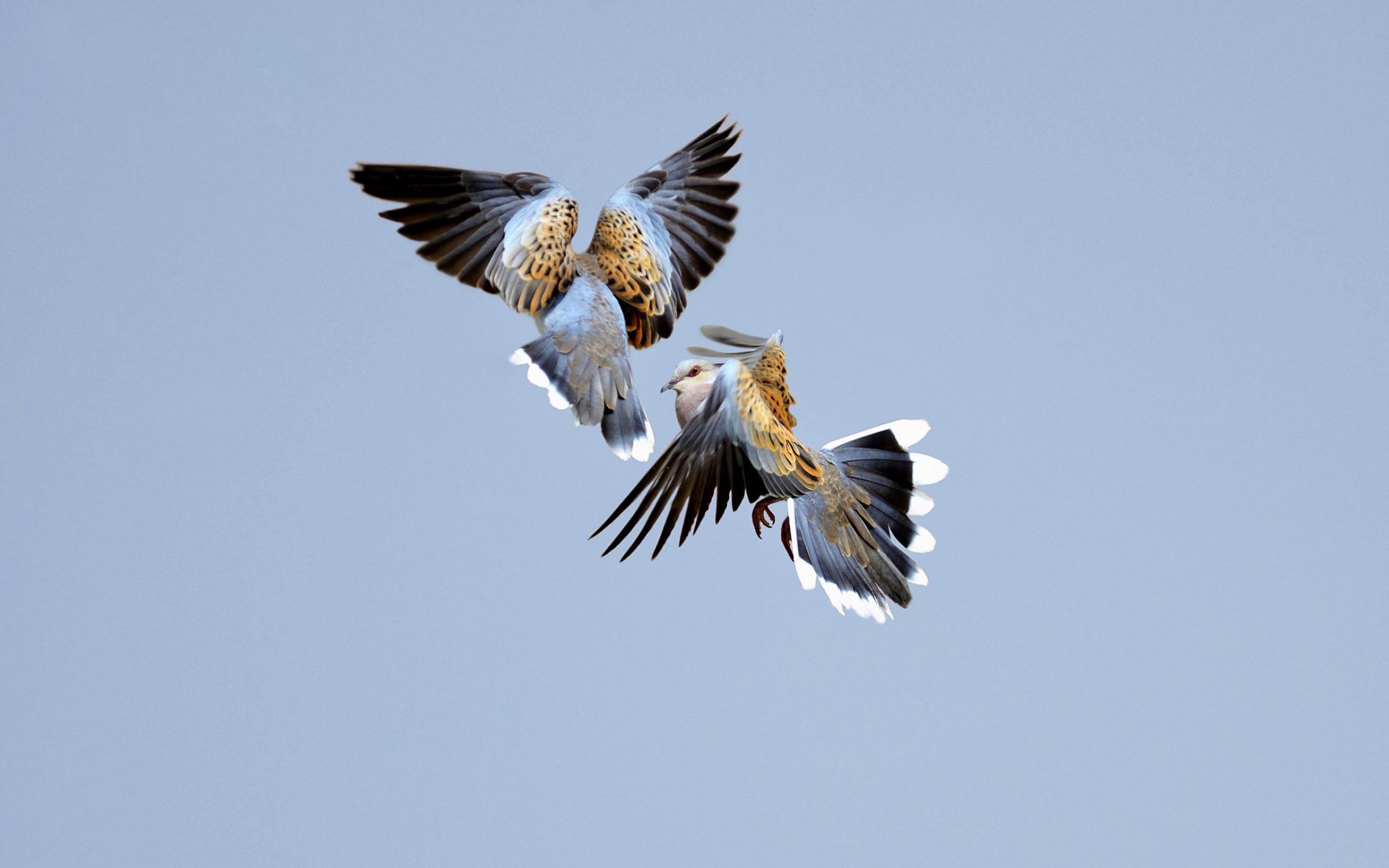Britain ranks among the most nature depleted countries on Earth. This is odd when you consider how in love we are as a people with the unique natural fabric of our own island, as well as the deep affinity we feel for the wildlife with which we share it. Sir David Attenborough is our national icon, his films about nature are more watched than pretty much anything else on television. So why have we allowed nature in our country to become so terribly degraded?
The British landscape was once awash with colour, but since the Second World War 97% of our wildflower-rich meadows have simply been erased, ploughed up and replaced with vast swathes of monotonous, silent, neon “green concrete”. Most adults can remember car windscreens splattered with insects after even the shortest of summer car journeys. No longer. Insect populations have crashed, and with them so much else.
Take our island’s wonderful birds. Turtle doves, symbols of love whose beauty, purring song and the tender affection they reserve for lifelong mates have inspired poets, musicians and painters through the ages. They are down a breath-taking 93% since the 1970s. Starlings, once so numerous that their vast flocks, known as “murmurations”, morphed into vast shape-shifting genies in one of nature’s most remarkable sights, have declined by 66%. Even the humble “cockney sparrow” is down 75%. Cuckoos, whose iconic call heralds the arrival of spring, are down 65%. Everywhere you look, the magical tapestry of life is becoming ever more threadbare.
Unsustainable farming methods must shoulder a significant share of the blame for this. More than two thirds of our island is farmed, and the decline of farmland wildlife has been especially stark. And it’s not just wildlife we’re losing. Have you ever wondered why our rivers and even the once-blue seas around Britain turn brown each autumn and spring? It is because unsustainable farming is causing the very soil, on which we depend for our survival, to vanish at a terrifying rate.
While there are many farmers out there who make a heroic effort to live up to their role as careful stewards of the land, many of which are represented by the wonderful Nature Friendly Farming Network, a radical war on nature has gripped farming in recent decades. The EU’s Common Agricultural Policy (known as the CAP), accounting for 35% of the total EU budget, has provided the principal impetus for this. Under the CAP, vast amounts of taxpayers’ money has been dished out each year to farmers according simply to how much land they farm. These subsidies drove most farmers to grub out ancient hedgerows, remove trees, ponds and wetlands, rough margins and any other natural (or “ineligible” in CAP speak) features in order to maximise space for harvesting subsidies.
At the same time, in a relentless effort to increase production, ancient wisdoms have been abandoned. Our ancestors understood that the rotation of livestock and crops is essential for maintaining the health of the soil, or that ploughing the earth on steep-sided valleys would cause the soil to wash away. As ecosystems have withered and the biological function of the soil has declined, farmers have had to resort to soaking the land in ever-greater quantities of chemical fertilizers, much of which is swiftly flushed with the rainfall into water courses, causing eutrophication, which smothers the life from our streams, rivers and estuaries. Pests, thriving in an environment that is out of kilter, are rampant – so much so that crops must be protected with a chemical arsenal of herbicides, fungicides and pesticides, many of which were originally designed in human warfare.
As people have grown steadily more vocal about what’s happening in our countryside EU policymakers responded with the creation of a second “pillar” of agricultural subsidy, known as Pillar 2, which allows 12% (currently) of the total CAP budget to be used to reward farmers for fixing some of the damage. But the remaining 88% of the subsidy budget pays little attention to any of these issues. No matter how much harm you inflict on the environment, no matter how great your contribution to soil loss and flooding, no matter how few the birds and other wildlife who find a home on your land, the cash keeps on coming. In this way, the CAP has wrought an annihilation of nature across Europe and in Britain.
The impact of the CAP has been especially harsh in our remoter, less agriculturally-productive landscapes, including our national parks. With around 12% tree cover, Britain is one of the least wild countries in Europe – principally because our uplands, once comprised of great wood pastures and temperate rainforests, were cleared in Victorian times for sheep. The environmental cost of trying to make intensive farming work in these parts of Britain has been catastrophic. Sheep, which now number a staggering 33 million in Britain, have almost entirely stripped the hills and valleys of their green mantle. With the exception of small pockets, trees, scrub, wildflowers, birdsong are largely absent from our uplands.
People think of our National Parks as great nature reserves, but they are not. Sadly, there is often less wildlife in these parts of the UK than in surrounding areas. Perhaps it is no surprise that not a single one of our upland areas makes The Telegraph’s annual Great British bucket list. In any other country, the uplands would be at or near the top of such a list – but in Britain we have decimated our wild places.
One of the consequences is flooding. The science is crystal clear (unlike the water in our rivers): if you strip the hills of nature you significantly exacerbate the cycle of flash-flooding and seasonal drought. Bare hills are simply unable to absorb and hold back water after heavy rainfall. Taxpayers have been forking out twice to maintain the status quo – in the form of farm subsidies and then again in the huge costs associated with mitigating and insuring against flooding, and in clearing up the mess when conventional flood protections fail.
Perhaps the worst part of the story is that environmental decline across our remoter landscapes has gone hand-in-hand with economic and social decline. Even with hand-outs from the EU, in much of Britain trying to farm intensively just does not pay. As the average age of hill farmers creeps ever higher, Britain’s upland communities are dwindling.
Leaving the EU has given us the opportunity to end this madness. The Agriculture Act 2020, first conceived by Michael Gove and shepherded through Parliament by George Eustice and his thoughtful, committed team of officials and Ministers at DEFRA, and signed into law by The Queen this month, replaces the appalling CAP with a new system built on the premise of “public money for public good”. Farmers who, as well as fulfilling their vital role as food producers, take seriously their responsibility as stewards of the natural environment will be rewarded by taxpayers for doing so.
Funding for the new scheme, dubbed ELM – for Environmental Land Management, will remain in aggregate at the same level as the old CAP (£2.5 billion annually), split across three tiers:
The Sustainable Farming Incentive will reward environmentally-sustainable land management in ways that all farmers can do. For example, the transition to regenerative farming approaches, such as no-till (not ploughing the land), integrated pest management(working with rather than against nature to control pests) and rotating livestock and crops;
Local Nature Recovery, which will pay farmers and land managers for making changes that support local nature recovery and deliver local environmental priorities. For example, re-meandering artificially straightened streams, thereby creating ribbon wetlands along valley bottoms that reduce flooding and provide year-round water and safe harbour for wildlife;
And Landscape Recovery, which will involve bespoke agreements to support long-term, landscape-scale projects, such as re-wetting degraded wetland landscapes, or the transition to a wilder way of farming and the restoration of Britain’s great wood pastures.
We know that, given space, nature bounces back fast. Our generation might well turn out be the one that turned the tide, and our children the first to live in a country richer in natural abundance and wonder than the one known by several previous generations. I believe that Michael Gove, his successors, and those around them, will come to be remembered more than anything else for this – the greatest win for nature we’ve ever known in this country, and a world first.
Governments around the world dish out more than $700 billion in farm subsidies annually. England will be the very first to embed the principle of environment restoration and stewardship at the core of its farm subsidies scheme. So while this is certainly a moment to be celebrated, we must get it right. The eyes not just of the devolved administrations of Northern Ireland, Scotland and Wales, but of the rest of Europe and of the world are on us.




